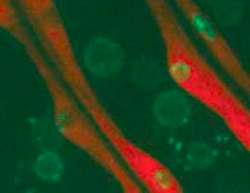(Medical Xpress) -- A team of scientists from the Friedrich Miescher Institute for Biomedical Research and the Hebrew University of Jerusalem describe in C. elegans the process leading to a rare form of Emery-Dreifuss muscular dystrophy, a disease caused by a mutation in lamin A in man. Lamin A not only gives shape to the nucleus, but here it is shown that it controls the positioning of genes in the nucleus, thereby guaranteeing proper transcription. In a paper appearing in Current Biology, the authors show that perturbation of tissue-specific gene localization leads to aberrant muscle structure and function.
In a collaborative effort between scientists at the FMI and in Israel, a disease-correlated mutation was reconstituted in the simple genetic organism, C. elegans. In the current study it is shown that the filamentous network formed by lamins is not only critical for the maintenance of nuclear shape, but it also contributes to the proper positioning of DNA, ensuring that silent genes and active genes are properly segregated in the nucleus.
Mutations in the genes that encode lamin proteins cause 14 different diseases in man, collectively termed laminopathies. These include early aging diseases and diseases that affect peripheral neurons, heart, skin, bones and muscles.
One of the muscle diseases caused by dominant mutations in the gene encoding lamin A is Emery-Dreifuss muscular dystrophy (AD-EDMD). It is characterized by a weakening in certain skeletal muscles and early contractures at the neck, elbows and the Achilles tendons, as well as cardiac conduction defects. How these mutations lead to the disease was largely unknown.
By manipulating the lamin gene in the worm Caenorhabditis elegans, Prof. Yosef Gruenbaum and his students Anna Mattout and Erin Bank, together with Prof. Susan Gasser and her collaborators Brietta Pike, Benjamin Towbin, Adriana Gonzalez and Peter Meister, were able to show that lamin is necessary for the positioning of regions in the DNA that are mostly inactive, so called heterochromatin.
They then introduced low levels of a lamin bearing a mutation that causes AD-EDMD in humans, into the worms and tracked their expression. In the worms expressing the mutant lamin, they detected abnormal retention of a muscle-specific gene array at the nuclear periphery. The animals expressing the mutant lamin had selectively perturbed structures of body muscle and reduced muscle function, which strongly resembled the situation in human patients.
One important conclusion of this study, which appeared today in the online edition of Current Biology, is that lamin filaments help arrange silent genes at the nuclear periphery and - during normal tissue-specific activation -- allow release of the activated normal gene. A disease-linked local mutation in lamin can then impair muscle-specific reorganization of genes during tissue-specific promoter activation in a dominant manner. This dominance and the correlated muscle dysfunction typify, for example, Emery Dreifuss muscular dystrophy.
More information: Mattout A, Pike BL, Towbin BD, Bank EM, Gonzalez-Sandoval A, Stadler MB, Meister P, Gruenbaum Y, Gasser SM (2011) An EDMD mutation in C. elegans lamin blocks muscle-specific gene relocation and compromises muscle integrity, Current Biology 21 doi:10.1016/j.cub.2011.08.030 [Epub ahead of print]
Provided by Friedrich Miescher Institute for Biomedical Research



















